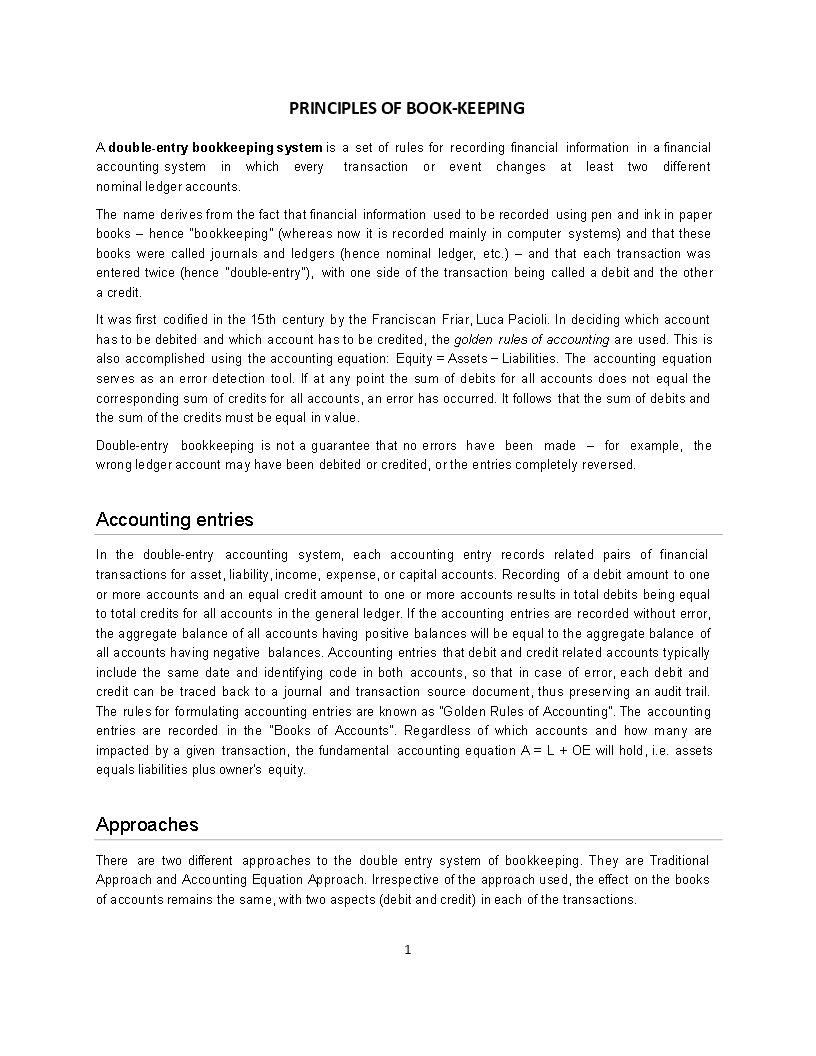Double Entry Ledger Paper

Speichern, ausfüllen, drucken, fertig!
How to create a Double Entry Ledger Paper? Download this explanation of the principles of bookkeeping/accounting template now!
Verfügbare Gratis-Dateiformate:
.docx- Dieses Dokument wurde von einem Professional zertifiziert
- 100% anpassbar
Finance Finanzen Education Bildung accounting Buchhaltung cash Kasse balance begleichen book Buch Account Konto Paper Papier Ledger Paper Ledger Papier
How to create a double entry ledger? Check here for an explanation of the principles of bookkeeping/accounting and download this useful double entry ledger paper template.
Emily had a small bakery that she loved dearly. She baked delicious pastries and cakes that were adored by her customers. However, as her bakery grew, Emily realized that she needed to keep track of her finances more effectively. She wanted to understand her profits, expenses, and how her business was doing overall. Emily decided to start using bookkeeping principles to manage her bakery's financial records. She set up a system to record every transaction, whether it was buying ingredients, selling pastries, or paying the rent. Each entry included the date, description, amount, and category of the transaction.
Every day, Emily diligently recorded her financial activities in a ledger. She categorized expenses like flour, sugar, and rent as "cost of goods sold." Revenue from selling pastries was categorized as "sales." Emily also kept track of her cash flow by recording incoming and outgoing payments. At the end of the month, Emily used her records to create financial statements. She prepared an income statement, which showed her total revenue, cost of goods sold, and gross profit. Emily also prepared a balance sheet, listing her assets (like baking equipment) and liabilities (like loans) to assess her bakery's financial health.
With these statements, Emily could make informed decisions about her bakery. She noticed that her profits were increasing, but so were her expenses. She realized she needed to find cost-effective suppliers for ingredients and consider adjusting her prices. Emily's bookkeeping efforts not only helped her manage her bakery efficiently but also gave her a clear picture of her business's financial performance. She could plan for the future, set financial goals, and make adjustments to ensure the success of her beloved bakery."
Explanation of Bookkeeping/Accounting Principles:
- Record Every Transaction: Just as Emily recorded every transaction in her ledger, bookkeeping involves recording every financial transaction of a business, including purchases, sales, and expenses.
- Double-Entry System: Emily's system of recording both sides of every transaction (debit and credit) aligns with the double-entry accounting system. This system ensures that every transaction has an equal and opposite effect on the accounting equation (Assets = Liabilities + Equity).
- Categorization: Emily categorized transactions into relevant accounts, such as "cost of goods sold" and "sales." This categorization is the foundation of the chart of accounts, which organizes financial activities for easy tracking and reporting.
- Ledger Entries: Emily's daily ledger entries are part of maintaining the general ledger, which is a record of all financial transactions. It helps in tracking individual accounts' balances.
- Financial Statements: By preparing income statements (profit and loss statements) and balance sheets, Emily followed the essential practice of creating financial statements. These statements provide insight into a business's financial health, performance, and position.
- There may also be equal decreases to both accounts. Accordingly, the following rules of debit and credit in respect to the various categories of accounts can be obtained. The rules may be summarized as below:
- Assets Accounts: debit increases in assets and credit decreases in assets
- Capital Account: credit increases in capital and debit decreases in capital
- Liabilities Accounts: credit increases in liabilities and debit decreases in liabilities
- Revenues or Incomes Accounts: credit increases in incomes and gains and debit decreases in incomes and gains
- Expenses or Losses Accounts: debit increases in expenses and losses and credit decreases in expenses and losses
- Financial Analysis: Emily's analysis of her financial statements demonstrates the importance of using accounting data to analyze business performance. Comparing revenue, expenses, and profits helps in making informed decisions and planning for the future.
- Cost Management: Emily's realization about increasing expenses and the need to find cost-effective suppliers highlights the significance of cost management in accounting. Monitoring and controlling expenses contribute to profitability.
- Planning and Decision-Making: Emily's ability to plan for the future and adjust her strategies based on financial data is a key aspect of accounting. Businesses use accounting information to set goals, forecast, and make informed decisions.
- Cash book Format: The cash book is balanced at the end of a given period by inserting the excess of the debit on the credit side as "by balance carried down" to make both sides agree. The balance is then shown on the debit side by "To balance brought down" to start the next period. As one cannot pay more than what he actually receives, the cash book recording cash only can never show a credit balance. The following is the simple format of a cash book:
- Date
- Particulars
- L.F. Amount
In summary, Emily's bakery story exemplifies the application of bookkeeping and accounting principles in managing financial records, making informed decisions, and ensuring the success of a business. The systematic recording, categorization, analysis, and reporting of financial data are vital elements in effective business management.
Customize to your liking, create your own, or get free lined paper designs now! Download this Double Entry Ledger Paper template now!
HAFTUNGSAUSSCHLUSS
Nichts auf dieser Website gilt als Rechtsberatung und kein Mandatsverhältnis wird hergestellt.
Wenn Sie Fragen oder Anmerkungen haben, können Sie sie gerne unten veröffentlichen.
